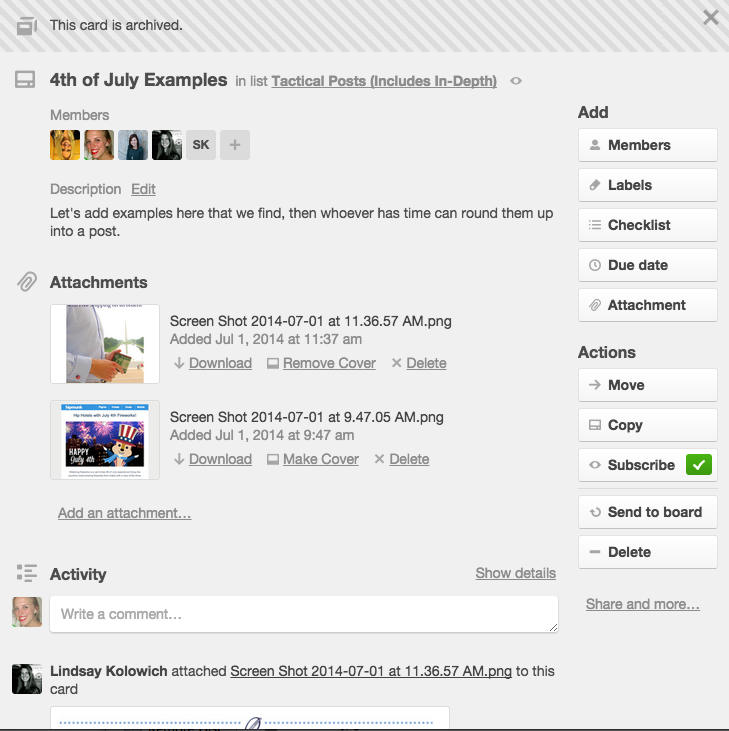 When I first started to blog for a living, I found it hard. Like, really hard. I always felt like I had writer’s block. It took me forever to write my first article that was over 1,000 words.
When I first started to blog for a living, I found it hard. Like, really hard. I always felt like I had writer’s block. It took me forever to write my first article that was over 1,000 words.
And I certainly didn’t feel validated after I hit publish — the posts would rack up a handful of shares and views, usually from my wonderful and supportive friends and family. (Thanks, guys.)
A few years later, blogging full-time isn’t as daunting. While it’s not always a walk in the park, I’ve developed some processes and discovered some shortcuts that have made it easier to create quality blog posts at scale. So if you’re struggling to think of new ideas to write about, balance blogging with the rest of your responsibilities, or publish posts consistently, keep on reading — below are some tried-and-true tips for being a more effective blogger.
1) Pick post topics based on well-converting offers.
If you’re reading this post, chances are you’re using your blog to do something for your business. Maybe that’s growing your blog email subscribers, becoming a lead in your database, or some other offer early on in the buyer’s journey. Whatever your goal, you should use it as a jumping off point for your blog content.
With only so much time in the day to blog, it’s crucial for you to focus on the posts that’ll get you the biggest return — which will usually the ones that are closely tied to the top-of-the-funnel offer you’re asking people to convert on.
Here’s how that works: Let’s say you’re a unicorn breeder and you’re using your blog to generate leads. One of your top sources for lead gen is a landing page for an ebook called The Ultimate Guide to Adopting a Unicorn You’ll Love for Life. If you wanted to get more bang for your blogging buck, you’d want to use that ebook topic as a jumping off point for future blog posts.
So instead of writing a post about "20 Famous Unicorns to Follow on Instagram," you’d prioritize writing a post about "20 Signs You Know You’re Ready to Adopt a Unicorn." Both formats have BuzzFeed-like appeal and probably would get a decent amount of traffic, but the latter is much more closely tied to the ebook, so you’ll be much more likely to get a larger volume of qualified leads from that post.
2) Choose blog post formats based on how much time you have.
If you’re working backwards from your point of conversion to determine what you blog about, you’re going to end up with a slew of topics that you can tackle in a bunch of different ways. In a perfect world, you’d spend a lot of time writing 3,000 words for each topic, complete with custom graphics, videos, and other interactive components.
But we all know we don’t live in a perfect world. You’ve got other projects to tackle and deadlines to hit, all while trying to accomplish certain blog goals — so you’ve got to develop a range of formats for most topics you cover that can be accomplished in a variety of time frames. That way, you can pick your format based on how much time you have in the day to do it.
For example, if I know I need to write a blog post on a topic about adopting unicorns but I only have an hour to do so, I wouldn’t try to tackle that 3,000-word deep dive. Instead, I’d try putting together a quick tip on the subject, or curating an infographic from someone in the industry. The quick tip or curated infographic would take me 30-40 minutes to finish, and they’d still perform as well as that deep dive.
So next time you need to write a blog post, think about how long you have to spend on it and adjust your format accordingly. (Bonus: your audience will appreciate the variety.)
3) Pivot post formats based on your resources.
Sometimes plans don’t work out. Maybe that interview you were banking on having juicy quotes from turned out to be frightfully boring, or that huge, data-driven post you were planning to write didn’t end up having that much data available. Even for experienced bloggers, it can hard to avoid these pitfalls. Instead, you should develop the ability to pivot post formats quickly.
For example, I once did an interview with someone that I thought was going to be a killer Q&A format. I figured I could just quickly transcribe our conversation, plop them in below the questions I asked, and then boom: the post would be done.
But that’s not what happened. When I began to transcribe the interview, I found that there was lots that still needed to be clarified to make it an engaging piece — so I decided to turn it into a list of takeaways instead. Yes, I needed to do more formatting and actually create a narrative for the piece, but it ended up doing way better.
The key takeaway here is this: Be flexible about your blog post formats — it could turn a dull piece into something awesome.
4) Keep a backlog of ideas and notes to tackle on a rainy day.
Truthfully, you’re never going to completely get rid of writer’s block — but, you can develop strategies to mitigate it as much as possible.
My go-to strategy is to keep a detailed backlog of future post ideas. My team and I gather these ideas on one Trello board, which we group by post format.

We also go one step beyond just adding the post title — we’ll add resources, examples, and tips within each Trello card, too. That way, if someone has writer’s block, they can easily just go into one of these cards and find both a ready-to-go topic and some jumping-off points they can use. This especially helps when we have posts that need lots of curated examples — below’s an example of how we used Trello for our Fourth of July post this year.

Having a backlog process set up ahead of time — and continually adding in ideas to that backlog — is a crucial part of mitigating writer’s block.
5) Know how and when to collaborate quickly.
Sometimes when you’re doing research, it’s better for you to do all of it yourself. For example, if you’re doing a deep dive into a very technical, complex issue, it’s easiest to do that whole process yourself so you can keep your facts straight when writing.
When you’re curating examples, on the other hand, it’s much better to divide and conquer. Asking your teammates to spend a few minutes recommending their favorite tips, companies, or influencers to profile is much easier than digging through the corner of the internet — and chances are, you’ll get a more diverse set of examples to use. While you may want to fact-check each submission before including it in the post, you can shave off hours of total research time this way.
So next time you’re writing a post, ask yourself whether you could speed up the total time you’re spending researching if you asked your teammates for help. If the answer is yes, send around a Google Doc or Trello card where everyone can submit their responses, suggestions, and examples. And when you’re writing up the post, be sure to give them some shout-outs — it’ll make them even more excited to contribute in the future.
6) Splice out over-detailed sections into new blog posts.
Have you ever gone down the rabbit hole in a certain section of a blog post? I certainly have — I’ve geeked out too hard about something that didn’t need that level of detail, and then felt stuck. Either I needed to cut down that section to flow properly with the rest of the piece, or beef up the rest of the piece to match that level of detail in that section. But when you’re crunched for time, neither of those options feel great.
Luckily, there is a third option that you can do: Copy that over-detailed section into a new blog post draft, publish it before the original post, and then link to it from the original post. That way, you can keep the original piece tight, but also give people the level of detail they need under that section. Plus, it gives you one more blog post to easily publish without tons of extra work. Pretty much the best case scenario all around.
7) Use under-detailed sections for new blog post ideas.
You can also do the opposite — take under-detailed sections as future blog post fodder. So if you have a post about how to feed unicorns, and you gloss over figuring out the proper amount of food to give them, you can just blow that topic out in another separate post (and link to it in the old post, of course).
8) Add deadlines to your work calendar.
Even if you don’t have a set-in-stone editorial calendar, holding yourself to firm deadlines is a great way to make sure you’re hitting your blogging goals. I personally like to add in my deadlines right in my calendar next to my other meetings so I have a much better idea of what I need to do in a given day — for example, if I have meetings from 2 p.m. until the end of the day, I’d add a calendar appointment at 1:30 p.m. that says "Finish Blog Post." That way, I know I have a set time to finish a blog post by (which makes me more motivated and productive), and it lets my teammates know what my priorities are for the day, too.
9) Take the time to develop a content creation cadence.
The best bloggers I know don’t write all day every day; instead, they split their day between writing, editing, researching, and accomplishing lots of little other tasks. This means hey’re constantly filling and producing their pipeline of posts, ensuring there’s not a moment without something to publish. Here’s roughly what that pipeline should look like:

Productive bloggers have posts in every stage of this process, and devote time to almost every single one of these stages every week. So in one given day, you’ll spend the morning researching one piece and reaching out to experts for quotes, and the afternoon working on revisions for a piece that’ll be published later that week.
Truthfully, it’s going to take some time to get to a point where you can have posts in each of these stages. At the very beginning, you’re going to have lots of posts in the first few stages and none in the latter, and over time you’ll start to build up to having posts in all stages of this process. It will take some time, effort, and coordination to get this process together, but once you have it together, it’s a great way to help you maintain a consistent volume of publishing.
10) Be okay with posts being "perfect enough."
Last, but certainly not least, is to get your blog posts to the "perfect enough" stage. While those two words may seem contradictory, they’ve helped me get over the fear of publishing anything that’s not 100% perfect. Because guess what: You’re never going to be perfect. There are always ways you could improve your posts — better image selection, tighter transitions, more accurate word choice, etc. — but spending too much time on those minutia will usually have diminishing returns.
Focus on getting your posts to be great. For example, instead of re-reading that 2,000-word post for the 10th time, just run it through Word’s spell check and the Hemingway app. While it may not catch everything, it will catch most. The key is to not overthink your post — you are going to make mistakes even if you are meticulous.
The best part is, most people won’t notice if you slip up. If they do, they usually are kind enough (or know-it-all-enough) to point out where you made a mistake, and you can quickly update the post to reflect those changes.
What other tips do you have for being a more efficient blogger? I’d love to hear what works best for you.
![]()







